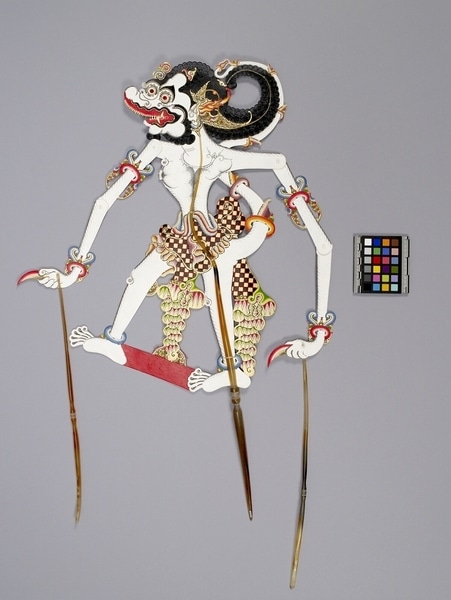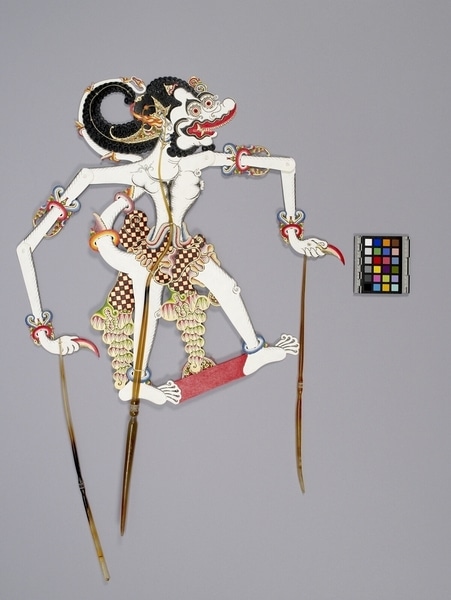Shadow Puppet Item Number: 1374/24 from the MOA: University of British Columbia


Description
A flat tall puppet, representing the character Hanoman, painted white with black curly hair curled outward and upward at the back and a gold-coloured headdress with red, white, blue, and green. The eyes are round and red. The mouth is red with gold-coloured teeth and fangs. The nose is long and pointed outward. He is wearing a red, black, and gold-coloured checkered outfit, blue anklets, and red bracelets with blue and green and gold-coloured curled protrusions. The shoulders and elbows are rotatable and a marionette stick is attached through the palm of each hand.
History Of Use
Wayang kulit shadow play is over 1000 years old. It is thought to be derived from the leather shadow puppetry traditions of southern India, like tholu bommalata, which came to Java with the spread of Hinduism in the first millennium. In Java - part of the Republic of Indonesia - this highly distinctive form of shadow puppetry is valued as a pusaka, a sacred treasure of the royal court of Yogyakarta. They are inspired by the Indian epics, the Ramayana and the Mahabharata, as well as stories of the history and folklore of Java, with a local spin. The plays are performed to mark special occasions such as birthdays, marriages, and religious events. Wayang shadow puppetry was inscribed on UNESCO's List of the Intangible Cultural Heritage of Humanity in 2008 (from Shadows, Strings & Other Things, 2019).
Item History
- Made by Pak Sagio (Maker) in Yogyakarta, Java, Indonesia before September 1989
- Collected by Dominique Major during 1989
- Owned by Dominique Major before October 17, 1989
- Received from Dominique Major (Seller) and Museum of Anthropology Shop Volunteers (Funding source) on October 17, 1989
What
- Name
- Shadow Puppet
- Identification Number
- 1374/24
- Type of Item
- puppet
- Material
- horn, paint, fibre and water buffalo skin
- Overall
- height 66.5 cm, width 29.0 cm, depth 1.7 cm
Who
- Culture
- Javanese
- Creator
- Pak Sagio (Maker)
- Field Collector
- Dominique Major
- Previous Owner
- Dominique Major
- Received from
- Dominique Major (Seller) and Museum of Anthropology Shop Volunteers (Funding source)
Where
- Holding Institution
- MOA: University of British Columbia
- Made in
- Yogyakarta, Java, Indonesia
When
- Creation Date
- before September 1989
- Collection Date
- during 1989
- Ownership Date
- before October 17, 1989
- Acquisition Date
- on October 17, 1989
Other
- Condition
- good
- Accession Number
- 1374/0024